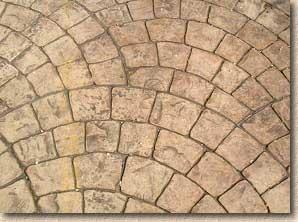For many years, concrete has been used as a simple, effective and low cost surface for all sorts of areas ranging from car parks to driveways to commercial freight yards. However, the one factor you rarely hear being praised is its looks. There's no point beating about the bush: plain concrete is bloody boring.
Techniques to improve the aesthetic appeal of monolithic* concrete pavements have been around since the fifties, notably in North America where concrete is possibly the most popular surfacing for patios, drives and 'yards', and in the southern hemisphere, particularly Australia. However, it is only since the mid 1980s that many of these techniques found their way to the North-West European paving market.
* A monolithic surfacing is, essentially, a pavement consisting of one big mass rather than being composed of discrete units such as block pavers or setts. Concrete, tarmac/asphalt/bitmac and resin bound aggregates are considered to be monolithic surfaces.
Undoubtedly, the most popular prettifying technique we see in Britain and Ireland is Pattern Imprint, sometimes known as 'Stamped', 'Imprinted' or 'Textured' concrete. From a sluggish start at the back end of the 1980s this technique has slowly but surely grown in popularity and now attracts a reasonable level of interest, in both the residential and the commercial markets, although it has nowhere near the market share of flexible block paving , natural stone or tarmacadam .

In recent years, refinements and developments of this technique have emerged and we now have stencilling techniques, high-strength textured overlays, colour staining, and sand-blasted concrete surfaces, as well as imprinted bitumens and resins. All these techniques are examined on the following pages...
